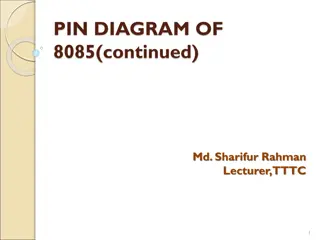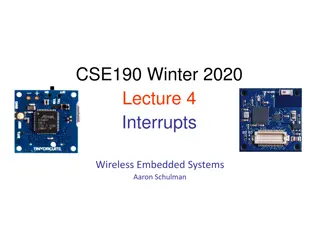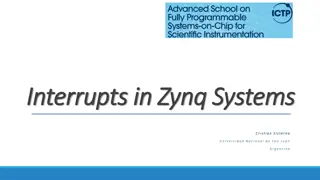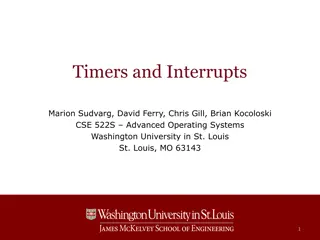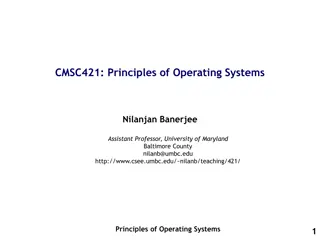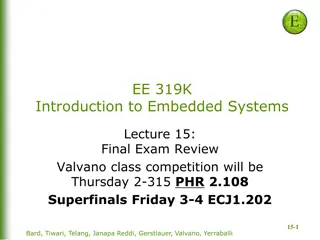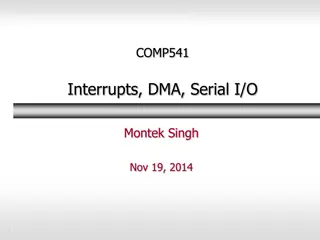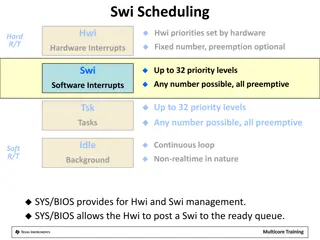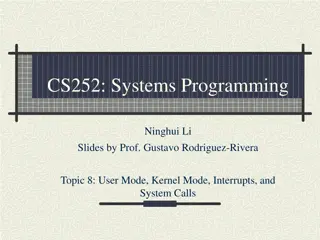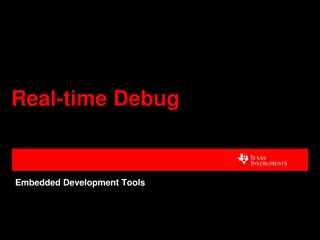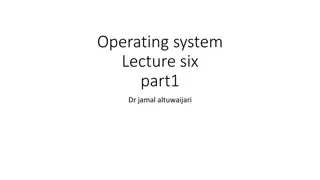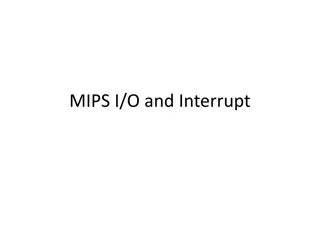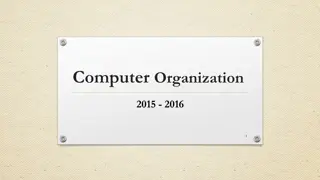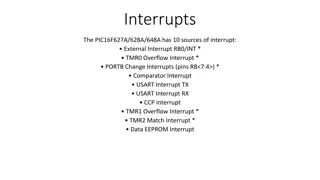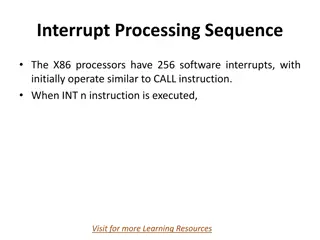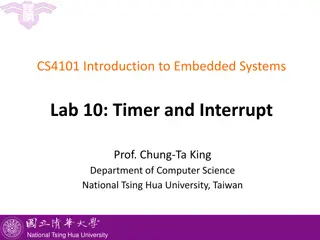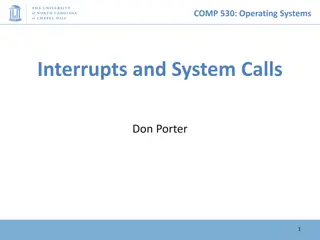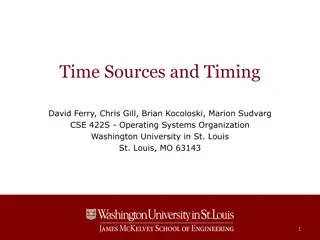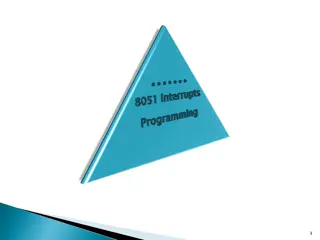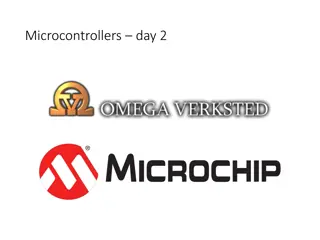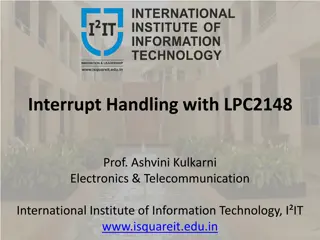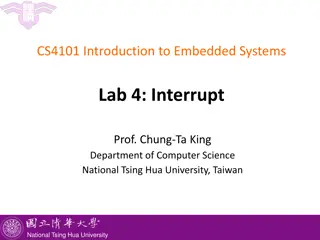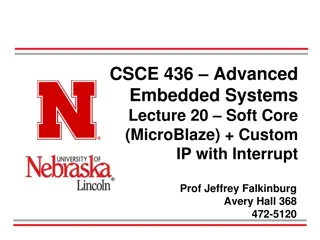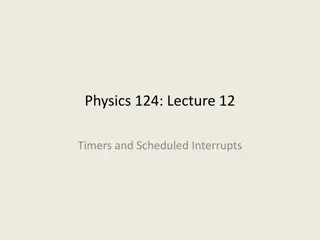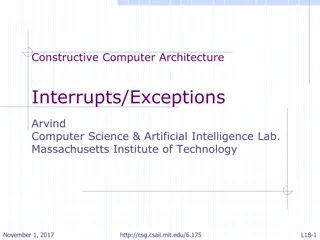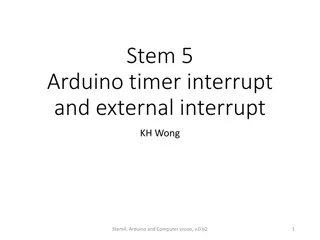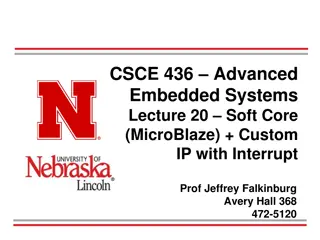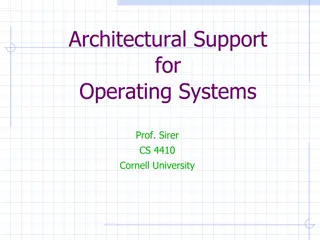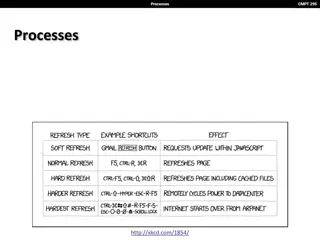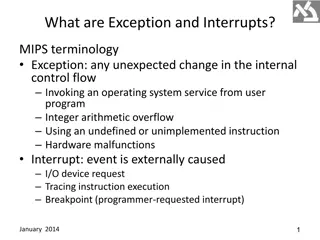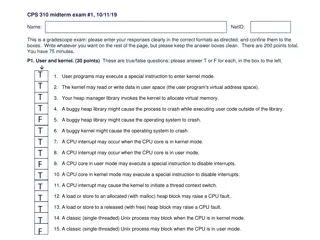Understanding Reorder Buffers in Computer Architecture
Explore the concept of Reorder Buffers (ROB) in computer architecture as a crucial component for precise interrupts and branch handling. Developed by a collaborative effort from notable professionals, delve into topics like branch predictors, speculation mechanisms, and practical examples of ROB ope
5 views • 29 slides
Comprehensive Guide to 8085 Microprocessor Interrupts and Pin Diagram
Explore the PIN diagram of the 8085 microprocessor, understand interrupts, including hardware interrupts like TRAP, RST, INTR, and the classification of interrupts such as maskable, non-maskable, vectored, and more. Learn about the sequence of steps during interrupts and their significance in microp
12 views • 31 slides
Understanding Interrupts in Embedded Systems
In embedded systems, interrupts play a crucial role in letting peripherals notify the CPU of state changes. They are events external to the current process that disrupt the normal flow of instruction execution, typically generated by hardware devices. By using interrupts, CPUs can efficiently handle
1 views • 12 slides
Understanding Processor Interrupts and Exception Handling in Zynq Systems
Learn about interrupts, exceptions, and their handling in Zynq Systems. Explore concepts like interrupt sources, Cortex-A9 processor interrupts, interrupt terminology, and the difference between pooling and hardware interrupts. Gain insights into interrupt service routines, interrupt pins, interrupt
0 views • 60 slides
Understanding Timers and Interrupts in Operating Systems
This content discusses the importance of timers and interrupts in operating systems, focusing on how they facilitate preemptive multitasking. It covers how hardware timer interrupts help in preemption of processes by the kernel, ensuring efficient task scheduling and resource management in modern op
4 views • 18 slides
Fundamentals of Operating Systems Explained
Explore the core concepts of operating systems, including kernel-userspace interactions, system calls, context switching, and virtual memory management. Delve into x86 assembly for system calls, hardware interrupts, and the flow of control during system call invocations. Gain insights into key compo
7 views • 19 slides
EE 319K Final Exam Review and Competition Details
The final exam for EE 319K Introduction to Embedded Systems will be similar in style to previous exams, covering topics like assembly and C programming, local variables, FSM, interrupts, ADC input, and DAC. Review definitions, fundamentals, and techniques using lecture notes, lab work, textbooks, ho
0 views • 27 slides
Understanding Interrupts in Computer Systems
Interrupts in computer systems play a crucial role in handling various events and managing the flow of instructions. This content discusses the types of interrupts, causes, handling procedures, and the role of supervisory modes in modern computers. It covers topics such as internal and external inte
0 views • 29 slides
Real-Time Interrupt Handling and Scheduling in SYS/BIOS
This content covers the management of hardware and software interrupts, interrupt priorities, scheduling rules, and execution flow for real-time systems using SYS/BIOS. It discusses the handling of interrupts by the Hardware Interrupt (Hwi) and Software Interrupt (Swi) components, priority levels, p
0 views • 4 slides
Understanding User Mode, Kernel Mode, Interrupts, and System Calls in Computer Architecture
In modern computers following Von Newman Architecture, programs and data are stored in RAM. The CPU, RAM, ROM, and devices communicate via address and data buses. The system operates in both kernel and user modes, where kernel mode allows full system control, while user mode restricts access for sec
0 views • 29 slides
Understanding Real-time Debug Techniques for Embedded Development
Real-time debugging in embedded systems involves different modes like stop mode and real-time mode, each offering unique capabilities for accessing memory, registers, and handling interrupts. This technique allows developers to examine and modify memory contents while the processor is running, enabl
0 views • 32 slides
Understanding Interrupt Processing in Operating Systems
An interrupt in an operating system disrupts the normal sequence of instructions executed by the processor. When an interrupt occurs, the OS takes control, saves the state of the interrupted process, analyzes the interrupt, and passes control to the appropriate routine. There are six classes of inte
0 views • 15 slides
Understanding MIPS I/O and Interrupt Handling
Delve into the world of MIPS architecture, exploring how I/O operations and interrupts are managed. Learn about memory organization, system functions, I/O registers, and kernel data. Discover how SPIM facilitates input and output handling, including reading from the keyboard and managing output. Div
0 views • 18 slides
Understanding Computer Organization: Instruction Set Architecture and Interrupts
Explore the critical concepts of Computer Organization focusing on Instruction Set Architecture (ISA) and Interrupts. ISA serves as the interface between hardware and software, enabling programmers to write machine language programs effectively. Learn about Application Binary Interface (ABI), interr
0 views • 26 slides
Understanding Interrupts in PIC16F Microcontrollers
Explore the key sources of interrupts in PIC16F627A/628A/648A, accessing registers, enabling interrupts, and managing local interrupts such as Timer 0 alarms and B0 pin changes. Learn how to set interrupts on desired events and understand the corresponding flag bits for interrupt occurrence.
0 views • 17 slides
Understanding Interrupts and Timers in Microcontrollers
Microprocessors function as finite state machines, with instructions loaded from memory and executed in sequence. However, interrupts allow for urgent out-of-turn servicing of signals, providing a way to handle asynchronous events. Learn how to utilize interrupts efficiently with examples on Arduino
0 views • 9 slides
Understanding Interrupt Processing Sequence in X86 Processors
X86 processors have 256 software interrupts, functioning similarly to a CALL instruction. When an INT n instruction is executed, the processor follows a sequence involving pushing the flag register, clearing flags, finding the correct ISR address, and transferring CPU control. Special interrupts lik
0 views • 10 slides
Embedded Systems Lab 10: Timer and Interrupt
This lab focuses on learning about timers and interrupts in embedded systems using MQX at National Tsing Hua University. It covers creating timer components, starting timers, and provides examples on simulating the control of an LED using timers. The content includes code snippets and explanations r
0 views • 15 slides
Understanding Operating System Interrupts and System Calls
Explore the fundamentals of operating system interrupts and system calls in COMP.530. Learn about synchronous and asynchronous interrupts, control flow handling, and the hardware tools available for irregular control flow. Delve into the key building blocks of operating systems such as context switc
0 views • 30 slides
Understanding Time Management in Operating Systems
Explore the concept of time in computer systems, including absolute and relative time, how the kernel tracks time, real-time clocks, system timers, and timer interrupts. Discover how time is a critical resource utilized by operating systems to provide essential functions for users.
0 views • 25 slides
ARM Cortex-M Interrupt and Exception Programming Overview
Explore the fundamentals of interrupts and exceptions programming in ARM Cortex-M microcontrollers. Topics include interrupt handling mechanisms, interrupt vector table, interrupt priorities, control registers, and transitioning from reset to boot programs. Gain insights into the privileged executio
0 views • 31 slides
Understanding Interrupts in 8051 Microcontroller
Interrupts in 8051 microcontrollers allow the system to respond to asynchronous events while multitasking on a single CPU, giving the illusion of handling many things simultaneously. They introduce the concept of priority, enabling preference over simultaneous interrupts. The interrupt vectors deter
0 views • 13 slides
Understanding Timers and Time Tracking in Embedded Systems
Explore the importance of timers in embedded systems for tracking time, managing interrupts, and ensuring accurate timekeeping. Learn about different peripherals used, such as real-time clocks and processor timers, to handle tasks like updating UI elements, triggering alarms, and measuring intervals
0 views • 24 slides
Understanding Fundamental Concepts of Interrupts in Embedded Systems
Explore the fundamental concepts of interrupts in embedded systems, including interrupt handling, maskability, priority, service routines, and interrupt vectors. Learn how interrupts allow the CPU to handle special events efficiently, coordinate I/O activities, and prevent CPU tie-up, enhancing syst
0 views • 57 slides
Understanding Microcontroller Interrupts and Applications
Explore the fundamental concepts of interrupts, PWM, timer/counters, and ADC in microcontrollers. Learn how to use interrupts for tasks like LED blinking, control LED brightness with PWM, and read voltage using ADC. Get insights on interrupt routines, enabling interrupts through registers, and tips
0 views • 32 slides
Understanding Interrupt Handling with LPC2148 in Electronics & Telecommunication
Introduction to interrupt handling with LPC2148 focusing on ARM processors, IRQ, FIQ, associated registers, interrupt enabling, types of interrupts (FIQ, Vectored IRQ, Non-Vectored IRQ), and differences between Vectored and Non-Vectored interrupts in the context of LPC2148. Discusses interrupt sourc
0 views • 15 slides
Understanding Interrupt Handling in MSP430 Embedded Systems
This lab explores the intricacies of handling interrupts in MSP430, covering types of interrupts, enabling interrupts, and the execution flow when an interrupt is requested and serviced. Topics include interrupt service routines, clearing interrupt flags, and enabling/disabling maskable interrupts.
0 views • 23 slides
Understanding Interrupts and MicroBlaze in Advanced Embedded Systems
Dive into the world of interrupts in embedded systems with a focus on MicroBlaze architecture. Learn how interrupts enable multitasking, the process of handling interrupts, and generating interrupts in MicroBlaze. Explore custom IP integration and gain insights into interrupt-driven programming. Dis
0 views • 32 slides
Understanding Timers and Scheduled Interrupts in Physics 124
The lecture covers timer basics for Arduino Uno/Nano, discussing available timers, prescaler options, PWM frequencies, and implementation details. It explains prescaling and frequency concepts, wrap times for Timer0, Timer1, and Timer2, and the importance of timed interrupts for creating a schedule
0 views • 21 slides
Project 2: Preemption in CS 4411 - Spring 2017
Project 2 focuses on addressing issues of selfish threads, starvation, and interruption handling within multi-level feedback queue scheduling. The project introduces clock interrupts, alarms, interrupt handlers, and addresses the importance of performance optimization for handling shared data struct
0 views • 19 slides
Understanding Computer Architecture Interrupts and Exceptions
Computer architecture interrupts and exceptions are essential for handling external events and unexpected conditions during program execution. Interrupts are caused by external events such as I/O requests, timers, or hardware failures, while exceptions occur due to specific instruction executions. W
0 views • 19 slides
Understanding Arduino Timer and External Interrupts
Interrupts play a crucial role in Arduino programming, allowing for immediate responses to external events. This content covers the concepts of timer interrupts and external interrupts, their applications, and how to use them effectively in Arduino projects. It explains how interrupts work, provides
0 views • 11 slides
Understanding Interrupts in Embedded Systems using MicroBlaze
Dive into the world of interrupts in embedded systems with a focus on using the MicroBlaze soft core processor and custom IP to handle interrupts efficiently. Learn about the significance of interrupt service routines, interrupt handling process, and how to generate interrupts in MicroBlaze for seam
0 views • 30 slides
Understanding Device Interfacing in Operating Systems
Explore the architectural support for operating systems, basic computer organization, keyboard mechanics, and device interfacing techniques such as memory-mapped I/O, polling vs. interrupts. Learn how CPUs interact with devices and the mechanisms behind efficient data processing in computer systems.
0 views • 29 slides
Understanding RTC Experiments with DS1307 for Arduino
Delve into the world of real-time clock (RTC) experiments using the DS1307 serial real-time clock with this comprehensive guide. Learn how to write to and read from the RTC, set up the board with Arduino, utilize interrupts for RTC reading, and more through step-by-step instructions and insightful v
0 views • 15 slides
Understanding Processor Cycles and Machine Cycles in 8085 Microprocessor
Processor cycles in microprocessors like 8085 involve executing instructions through machine cycles that are essential operations performed by the processor. In the 8085 microprocessor, there are seven basic machine cycles, each serving a specific purpose such as fetching opcodes, reading from memor
0 views • 17 slides
Understanding Exceptional Control Flow in Computer Systems
Control flow mechanisms in computer systems have evolved to handle exceptional events triggered by external system states. This includes exceptions, interrupts, and context switches that enable the CPU to respond to events like data arrival, user inputs, and system timeouts. Exception handling invol
0 views • 66 slides
Understanding Control Flow in Computer Systems
Explore the intricacies of control flow within computer systems, from the basics of processors executing instructions to handling exceptional control flow scenarios like interrupts and traps. Learn how control is transferred between processes and the operating system, the role of multi-process appli
0 views • 26 slides
Exception Handling and Interrupts in MIPS Architectures
Exception and interrupts in MIPS play a crucial role in handling unexpected events and external requests efficiently. Exceptions include changes in control flow, arithmetic overflows, and hardware malfunctions, while interrupts are externally caused events like I/O requests. When an exception occurs
1 views • 29 slides
Understanding User and Kernel Modes in Operating Systems
The content provided discusses various aspects of user and kernel modes in operating systems through a set of true/false questions related to user programs, CPU interrupts, heap management, and process behavior in different modes. It touches on the role of the kernel in managing virtual memory, hand
0 views • 10 slides

